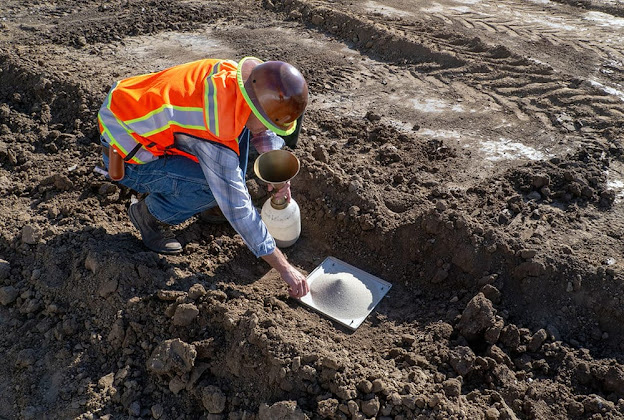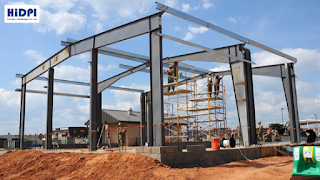What is a concrete mix design- Rcc construction company
A concrete mix design is defined because the appropriate selection and proportioning of constituents to supply a concrete with pre-defined characteristics within the fresh and hardened states.
Moreover, concrete mixes are designed in order to achieve defined workability, strength, and durability. Finally, this text presents factors affecting the selection of concrete mix design.
The basis for selection and proportioning of materials
- The structural requirements of the concrete
- environmental conditions
- The job site conditions, the methods of concrete production, transport, placement, compaction, and finishing
- The characteristics of the available raw materials
The various factors affecting the selection of concrete mix design are:
1. Compressive strength of concrete
Concrete compressive strength considered because of the most vital concrete property. It influences many other describable properties of the hardened concrete.
The mean compressive strength required at a selected age, usually 28 days, determines the nominal water-cement ratio of the combination.
ISO 456-200, British Standard, and Euro code utilize the term mean compressive strength which is slightly greater than characteristic compressive strength. However, the ACI Code does not use such a term.
Another factor that influences the concrete compressive strength at a given time and cured at a specified temperature is compaction degree.
Finally, it is demonstrated that the concrete compressive strength of fully compacted concrete is inversely proportional to the water-cement ratio.
2. Workability of concrete
Concrete workability for satisfactory placement and compaction depends on the size and shape of the section to be concreted, the amount and spacing of reinforcement, concrete transportation and placement, and compaction technique.
Additionally, use high workability concrete for the narrow and sophisticated section with numerous corners or inaccessible parts. This will ensure the achievement of full compaction with a reasonable amount of effort.
Frequently, slump test values used to evaluate concrete workability. According to IS 456:2000, slump test values for various reinforced concrete sections which range from 25 mm to 175 mm.
3. Durability of concrete
The ability of concrete to withstand harmful environment conditions termed concrete durability.
High strength concrete is usually more durable than low strength concrete.
In the situations when the high strength isn't necessary but the conditions of exposure are such high durability is significant, the sturdiness requirement will determine the utilized water-cement ratio.
Concrete durability decreases with the increase of the w/c ratio.
4. Maximum nominal size of aggregate
Reinforcement spacing controls maximum aggregate size.
The aggregate size is inversely proportional to the cement requirement for the water-cement ratio. This is because workability is directly proportional to the size of the aggregate.
However, the compressive strength tends to extend with a decrease in the size of aggregate. Smaller aggregate size offers a greater surface area for bonding with a mortar mix that gives higher strength.
IS 456:2000 and IS 1343:1980 recommends that the nominal size of the aggregate should be as large as possible.
Finally, in accordance with the ACI code, the maximum aggregate size shall not exceed minimum reinforcement spacing, bar diameter, or 25mm.
5. Grading and type of aggregate
Aggregate grading influences the mix proportions for specified workability and water-cement ratio.
The relative proportions between coarse and fine aggregate in concrete mix influence concrete strength.
Well graded fine and coarse aggregate produce a dense concrete due to the achievement of ultimate packing density.
If available aggregate, which obtained from a natural source, does not conform to the specified grading, the proportioning of two or more aggregate becomes essential.
Additionally, for specific workability and water to cement ratio, the type of aggregate affects aggregate to cement ratio.
Lastly, an important feature of a satisfactory aggregate is the uniformity of the grading that achieved by mixing different size fractions.
6. Quality Control at site
The degree of control could be evaluated by the variations in test results.
The variation in strength results from the variations within the properties of the combined ingredients, additionally to lack of control of accuracy in batching, mixing, placing, curing, and testing.
Finally, the lower the difference between the mean and minimum strengths of the mix lower will be the cement-content required. The factor controlling this difference is termed as internal control.
RCC construction company:
HIDPL is known for creating engineering solutions that are technically feasible, for RCC structures like high rise buildings. We keep abreast of current trends and update ourselves regularly on the latest software such as STAAD PRO & ETABS with construction materials and innovative design methods in structural engineering that match international standards.
Having experience creating almost the world’s largest dome design and getting proof checked from IIT. Our key objective is to ensure that all our projects are completed according to the specified time schedule.




What Is A Concrete Mix Design- Rcc Construction Company >>>>> Download Now
ReplyDelete>>>>> Download Full
What Is A Concrete Mix Design- Rcc Construction Company >>>>> Download LINK
>>>>> Download Now
What Is A Concrete Mix Design- Rcc Construction Company >>>>> Download Full
>>>>> Download LINK rT